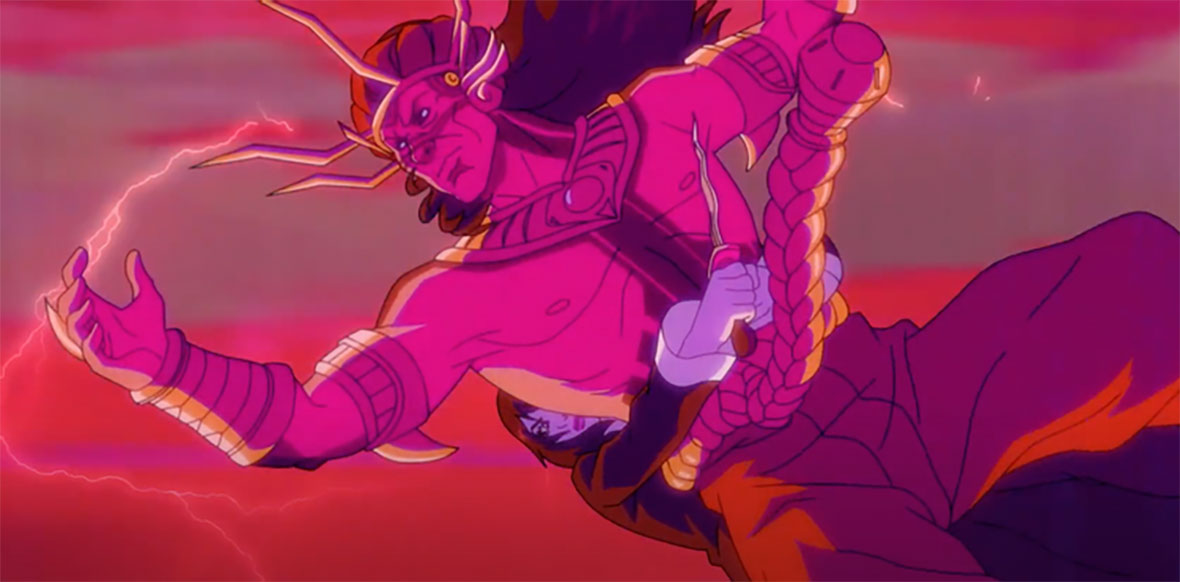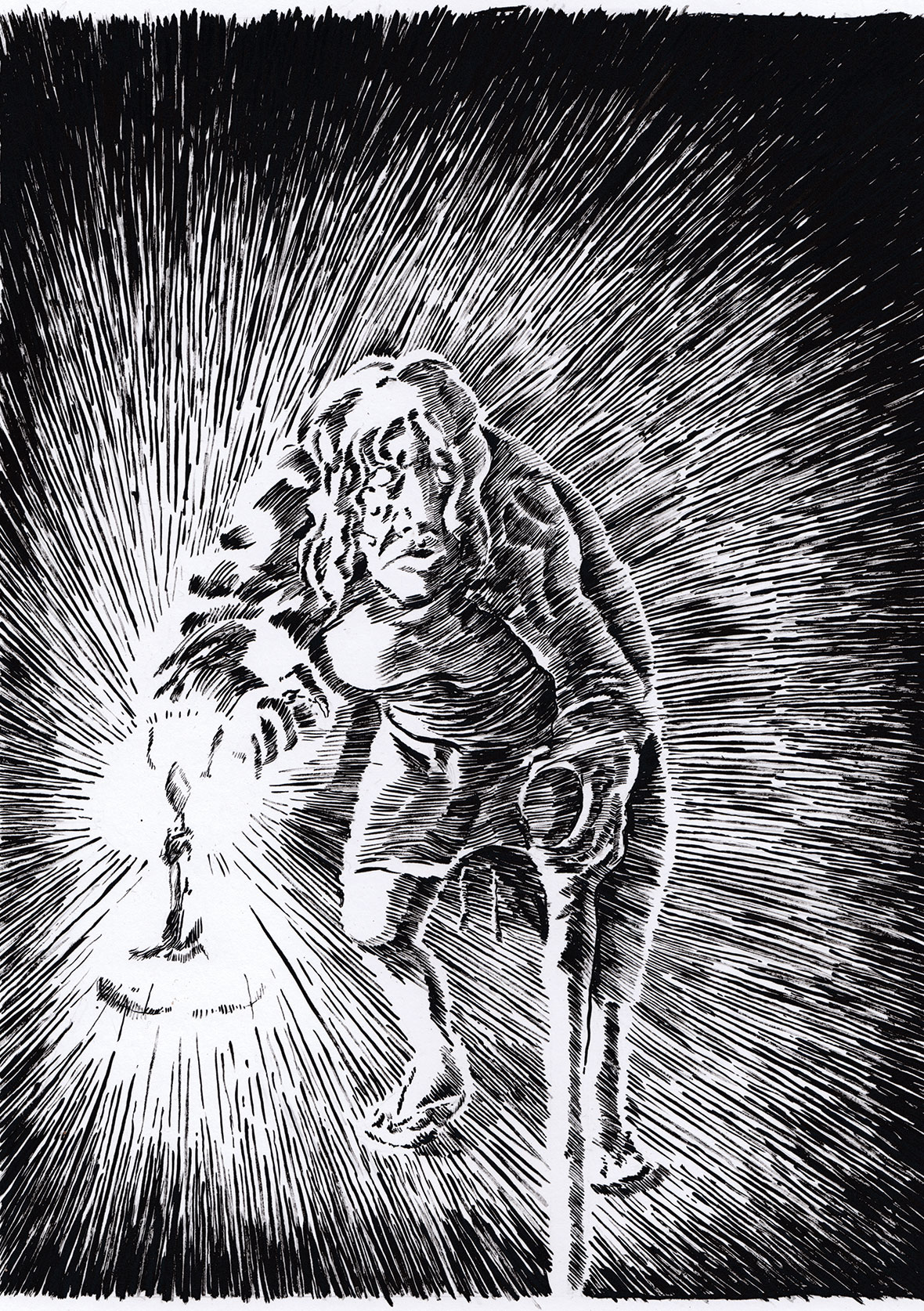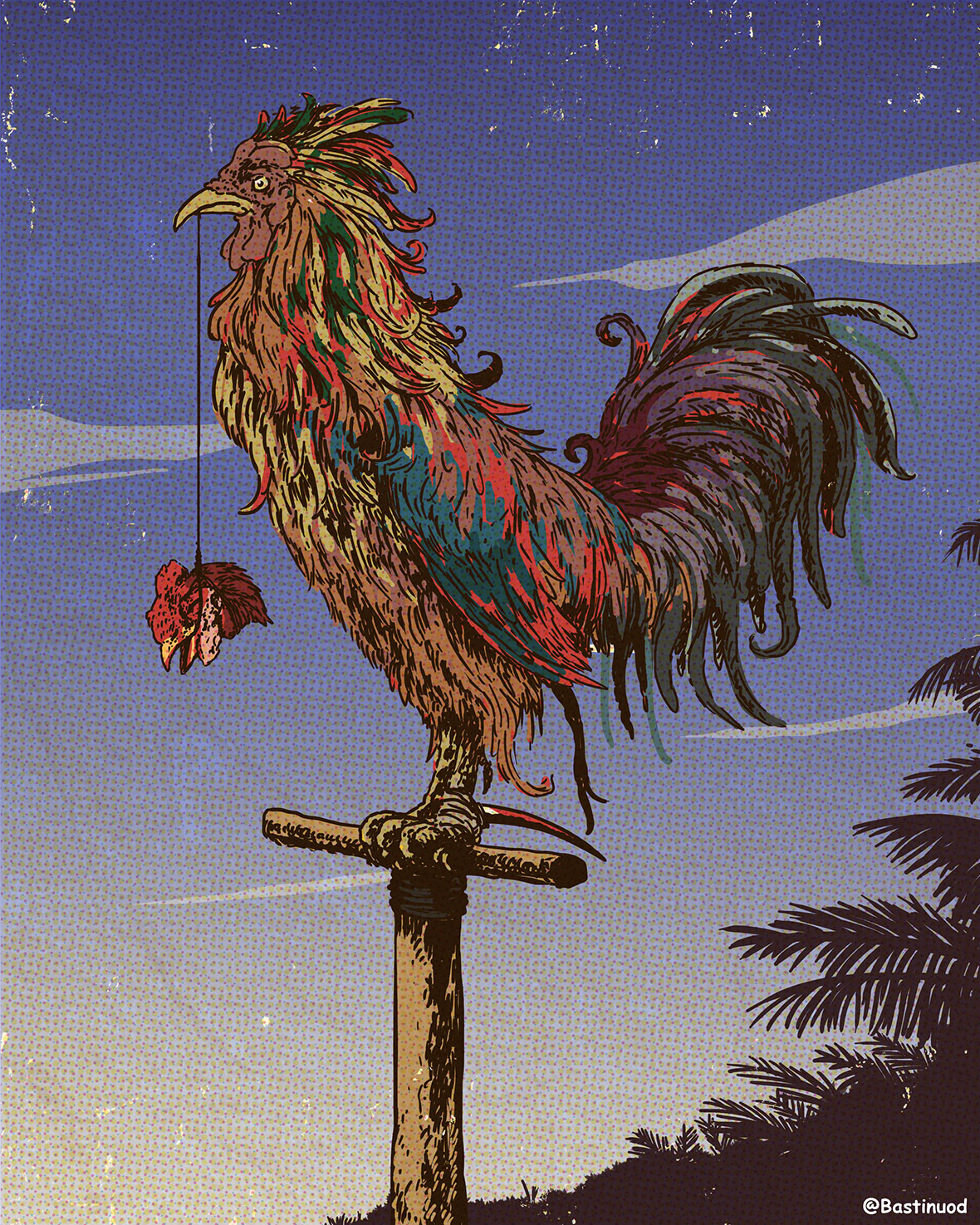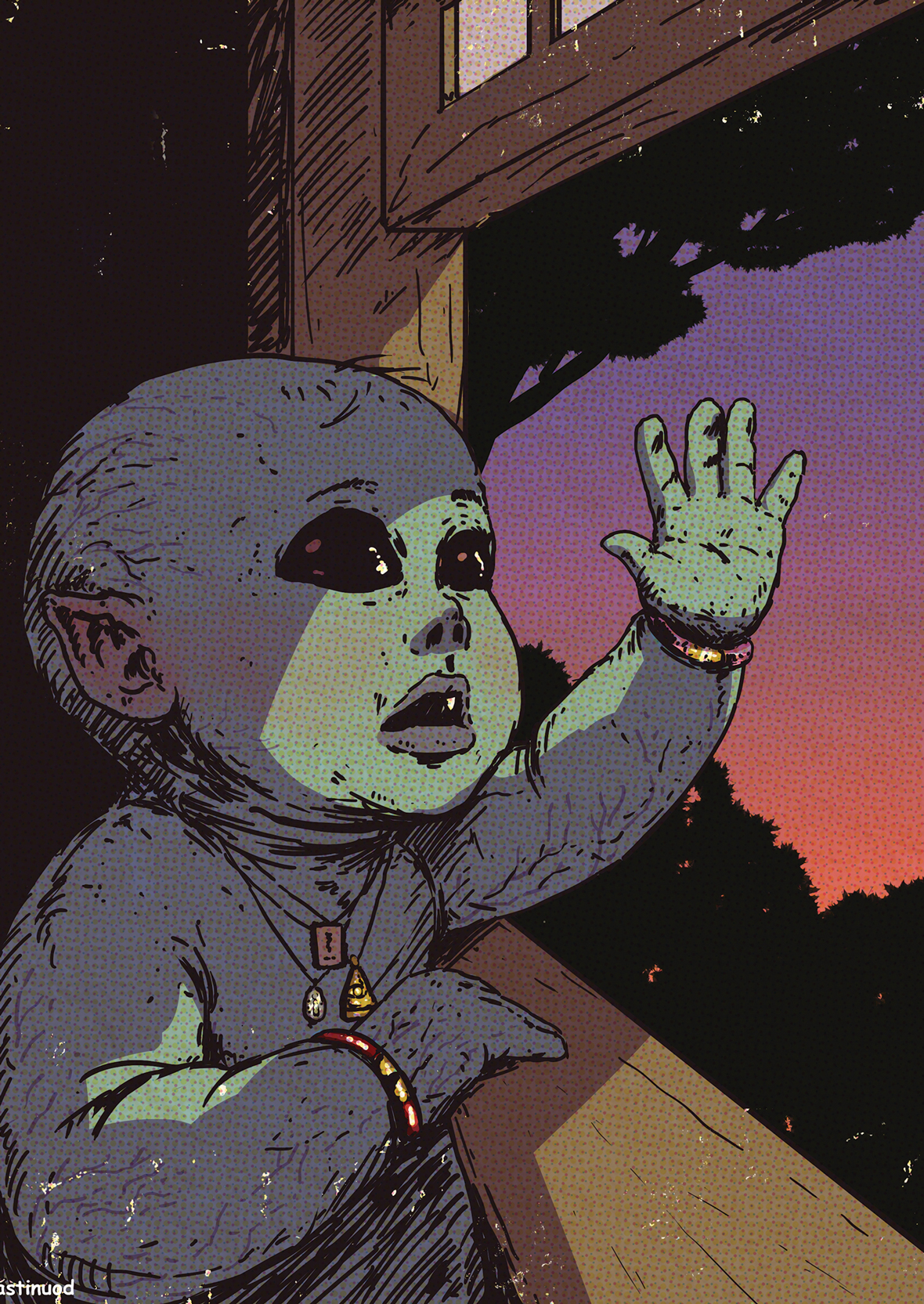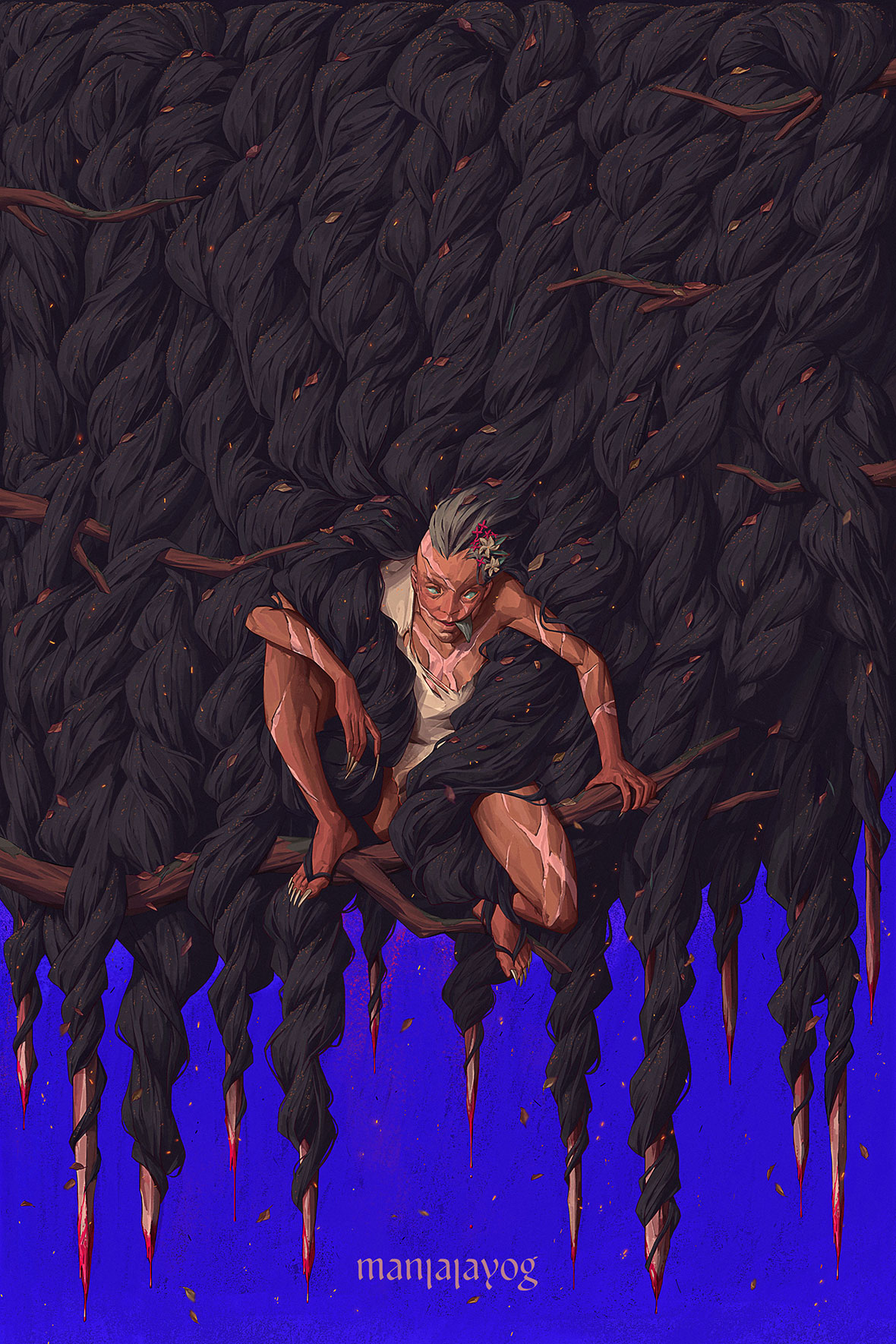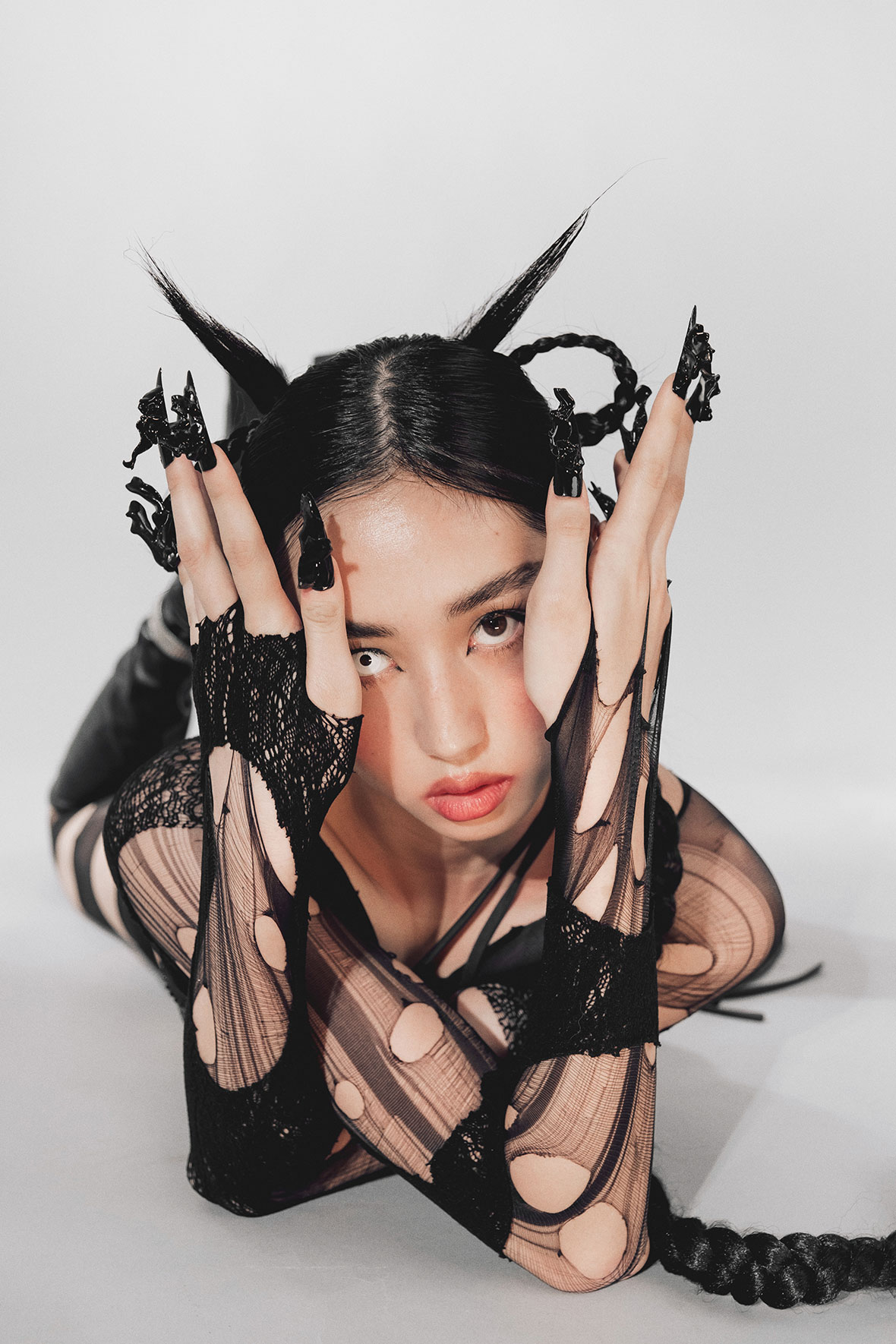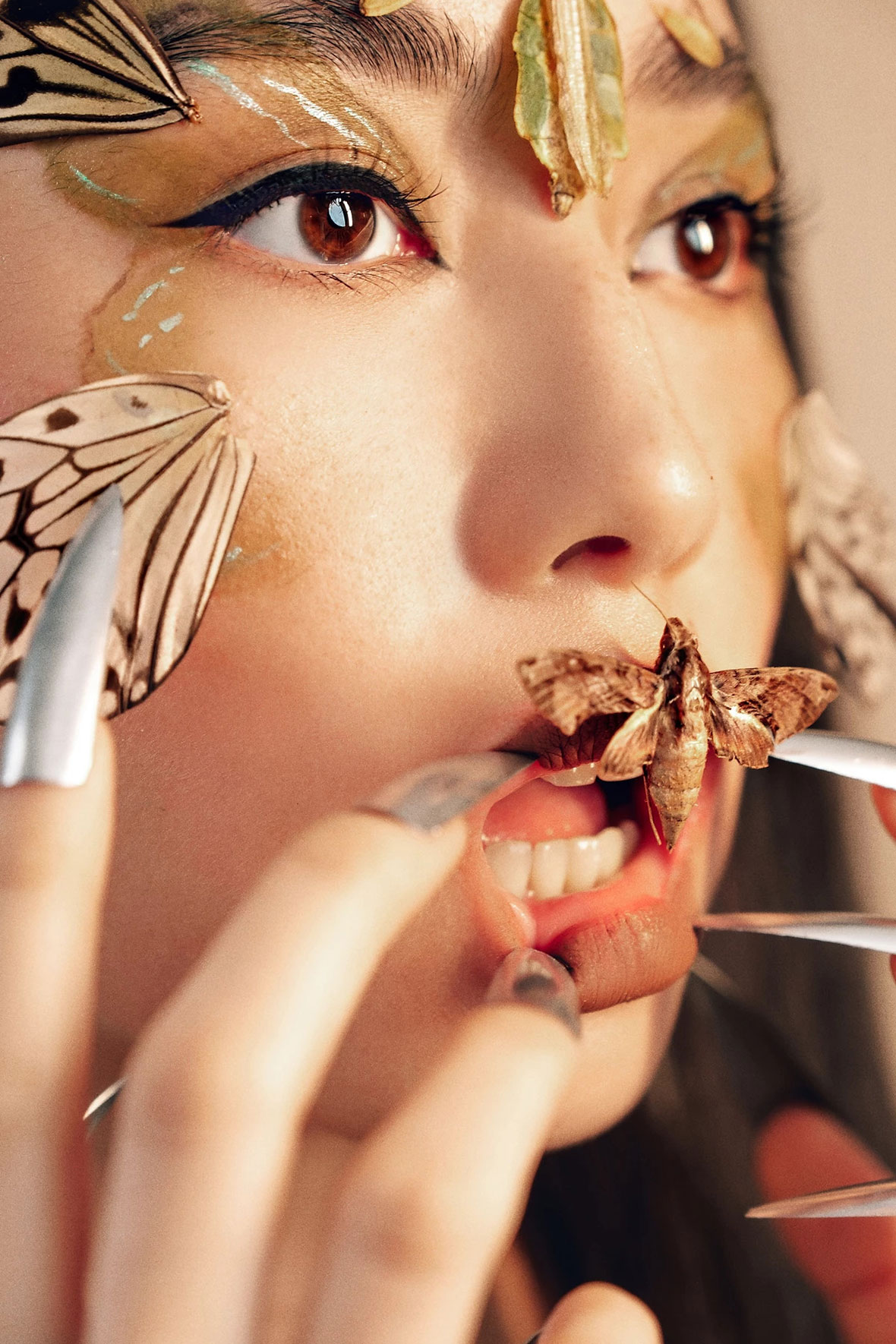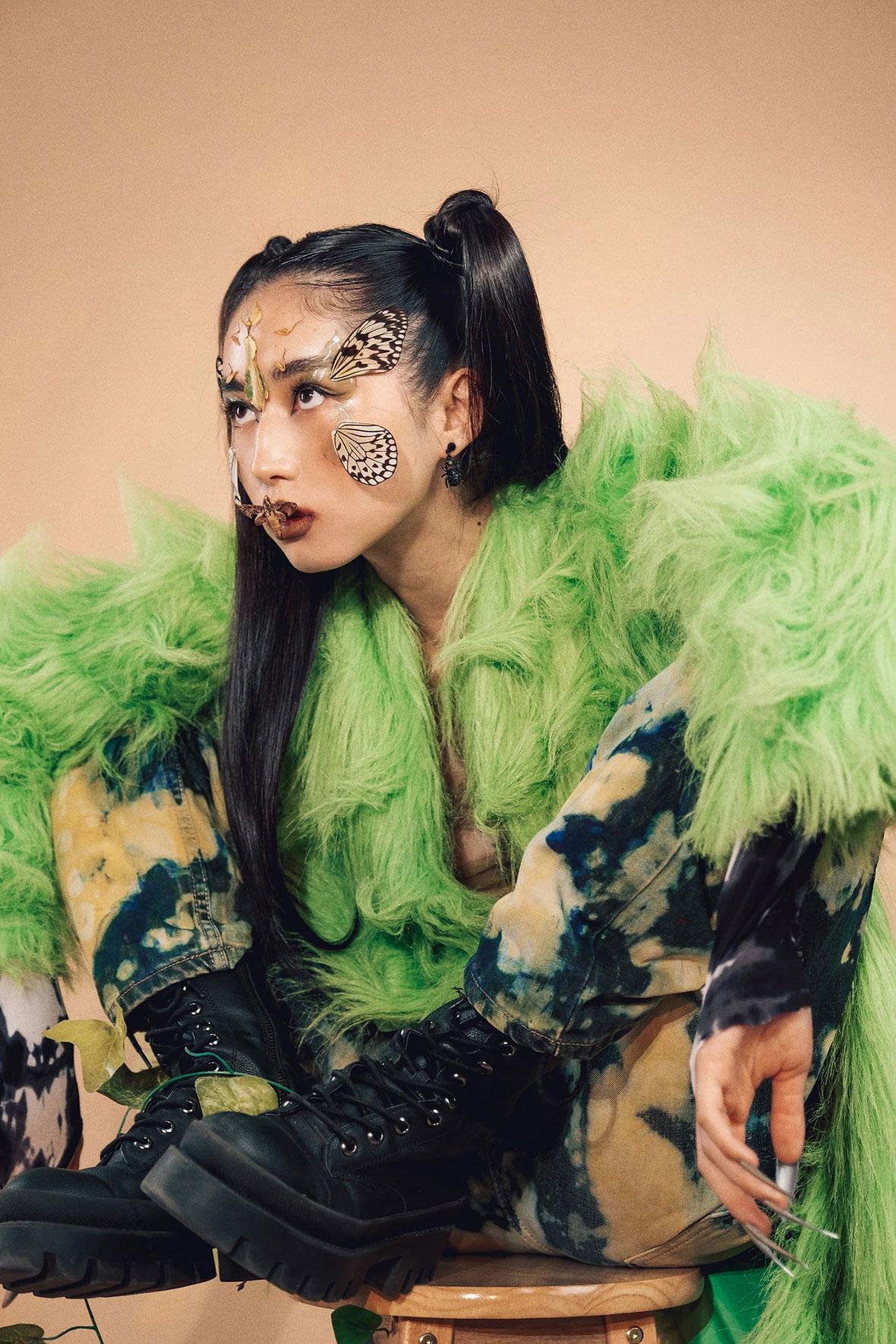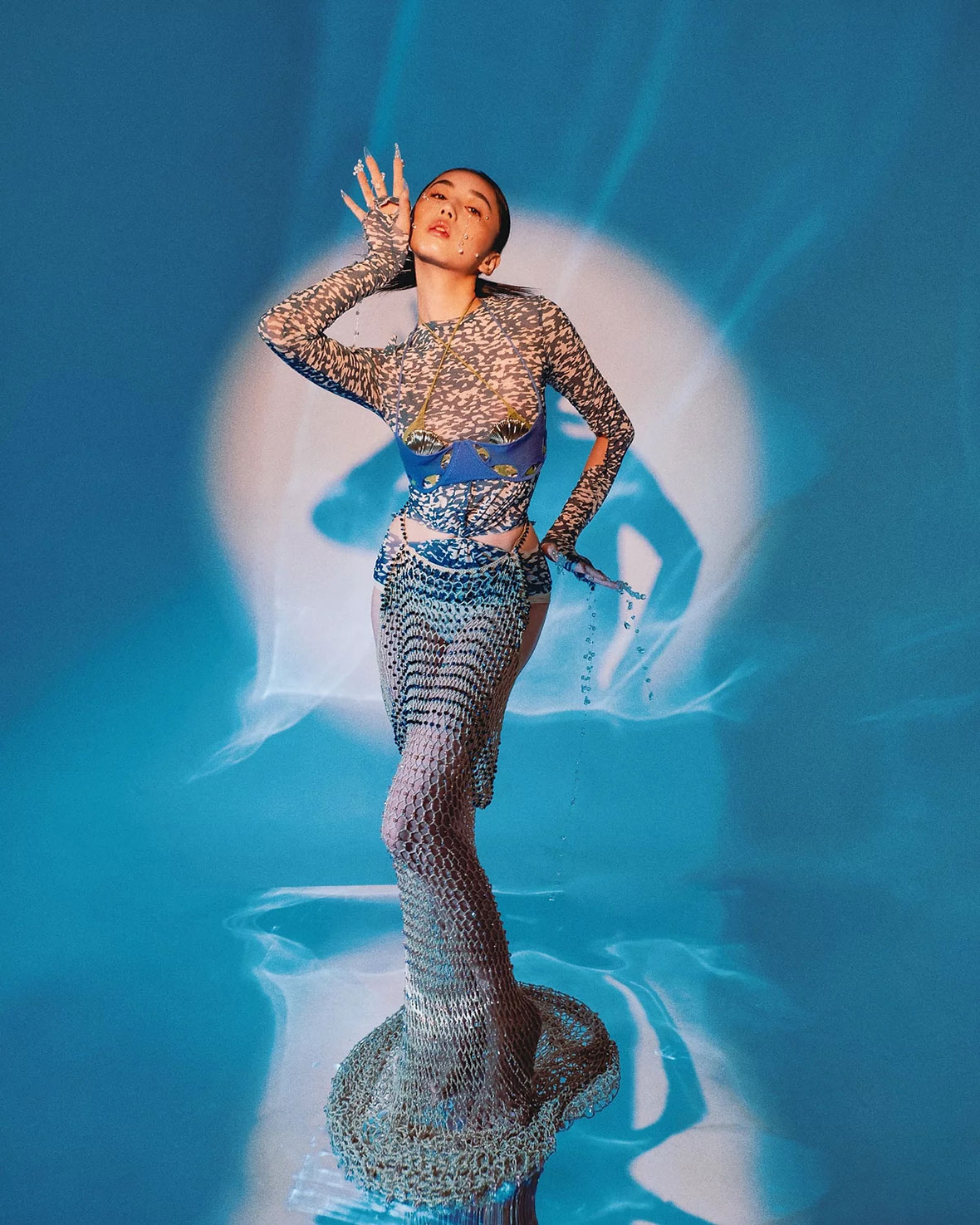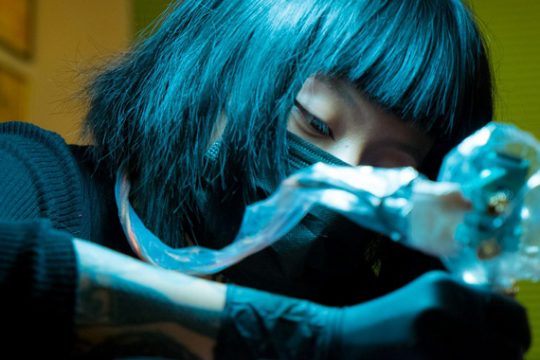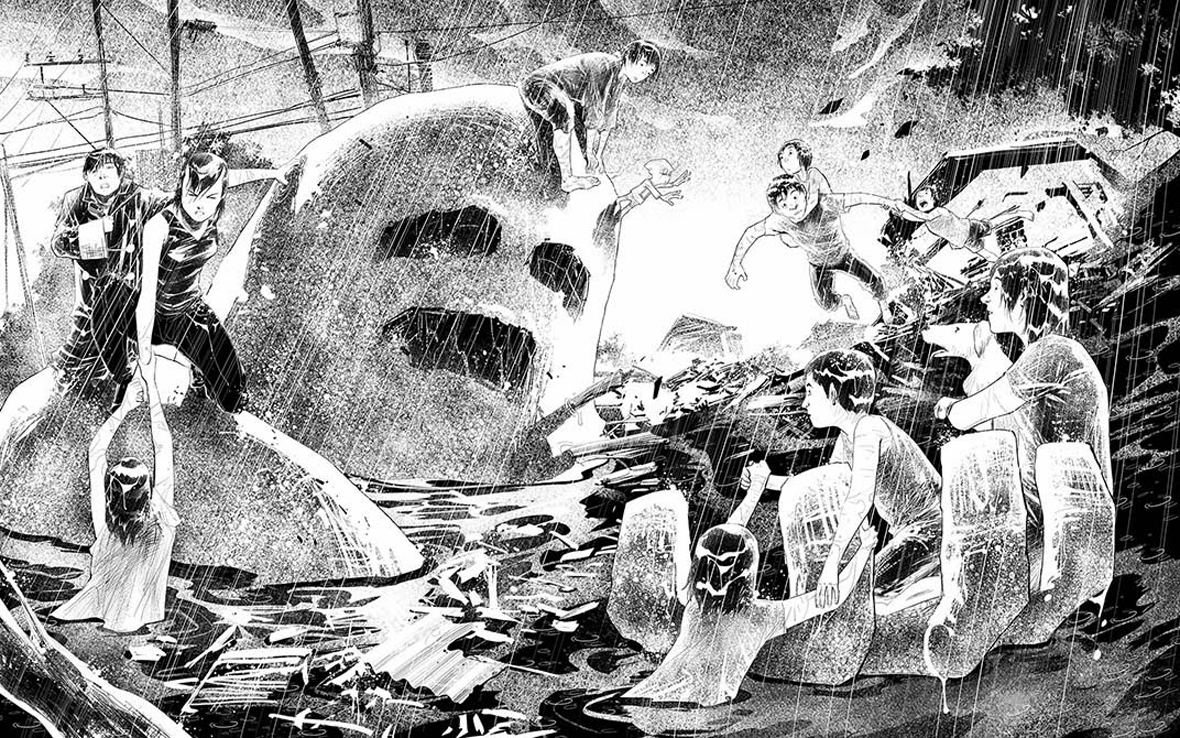
An elevated streetcar screeches to a halt, its darkened silhouette sitting beneath the glare of a giant LED billboard. The passengers disembark onto the tracks, only to be swarmed by fanged creatures. This is the opening scene of “Trese,” an animated series responsible for the most famous appearance of Filipino folklore on a global platform. The show is set in the dark megalopolis of a fictional Manila, and brings to life a cast of creatures from Filipino myths in a contemporary, neo-noir storyline. “Trese” follows its namesake hero, a detective supported by magical bodyguards. The trio is called on by the police when supernatural crimes are committed, which begins happening with increasing frequency. While the show is currently the most well known, there are a number of artists today who continue these traditions through contemporary art forms, as many generations have done before them. You can find folklore in nearly every form of art in the Philippines today—in fashion editorials, illustrations, fine art, and even graffiti. These artists see it as a way to explore Filipino identity, to decolonize their art, or to revisit fond childhood memories.
随着一声巨响,一辆高架有轨电车紧急刹停,漆黑的车身停靠在一块巨型 LED 广告牌的眩光之下。乘客纷纷下车走上铁轨,殊不知身边长满獠牙的怪物正朝着他们蜂拥而至。这是动画片《灵探特莱丝》(Trese)的开场。该动画将于 Netflix 平台放送,内容是诸多菲律宾家喻户晓的民间传说。片中以虚构马尼拉为背景,运用“新黑色”(Neo-noir)风格,生动呈现了菲律宾神话故事中的鬼怪形象。《灵探特莱丝》的主角特莱丝是一位神探,拥有两位魔法保镖助手。因为超自然案件近来频频繁发生,警方找到这三人寻求帮助。
如今,这部动画在网上已有较高的知名度,但其实,一直以来还有很多艺术家通过艺术的方式来讲述当地民间传说。在今天的菲律宾,从时尚杂志、插图、美术作品乃至涂鸦,几乎每一种艺术形式都能找到民间传说的元素。对于艺术家而言,这是他们探索菲律宾身份、非殖民化艺术以及重温美好童年记忆的一种方式。
Filipino folklore is a mix of Animism (the belief that places and creatures have their own spiritual essence) and local superstition whose roots in the archipelago stretch back to a time before Spanish colonization in the late 1500s. The mythological characters that populate these stories are often mischievous and sometimes outright demonic, but a few are also known to provide blessings. Although the specifics change from region and group, there is a lot of overlap across the country with the same concepts, even if they at times appear with different names and minor details. Many of these stories have pre-colonial roots, but they’re frequently altered from their origins by the widespread adoption of Catholicism and other contemporary influences.
菲律宾民间传说信奉泛灵论(即相信所有地方和生物都有灵魂或精神的存在),其最早可追溯到 16 世纪后期,即西班牙殖民之前的时代,后来混杂了当地的迷信文化造就了现在的样子。故事中的角色通常耍宝顽皮,有时则是彻头彻尾的恶魔,还有一些是能带来祝福的善良角色。虽然角色在每个地区的叫法不同,但往往大同小异,有着大致相同的背景。这些故事大都源自前殖民时期,后来受到天主教和不同时代的影响,而不断被后人改编。
。
无法观看?前往腾讯视频
Belief in and discussion of folklore is more common in the provinces, but it certainly makes its way into the city as well. Trese, which was originally a Filipino komik before its animated adaptation by Netflix, makes a point of reimagining these mythological characters by removing them from their rural origin stories and placing them in urban settings. So for example, instead of challenging people to wrestle in the forest, the Tikbalang competes in drag racing. And the Nuno sa Punso becomes something more like a Nuno sa Sewer, since it lives under the street instead of a mound of dirt.
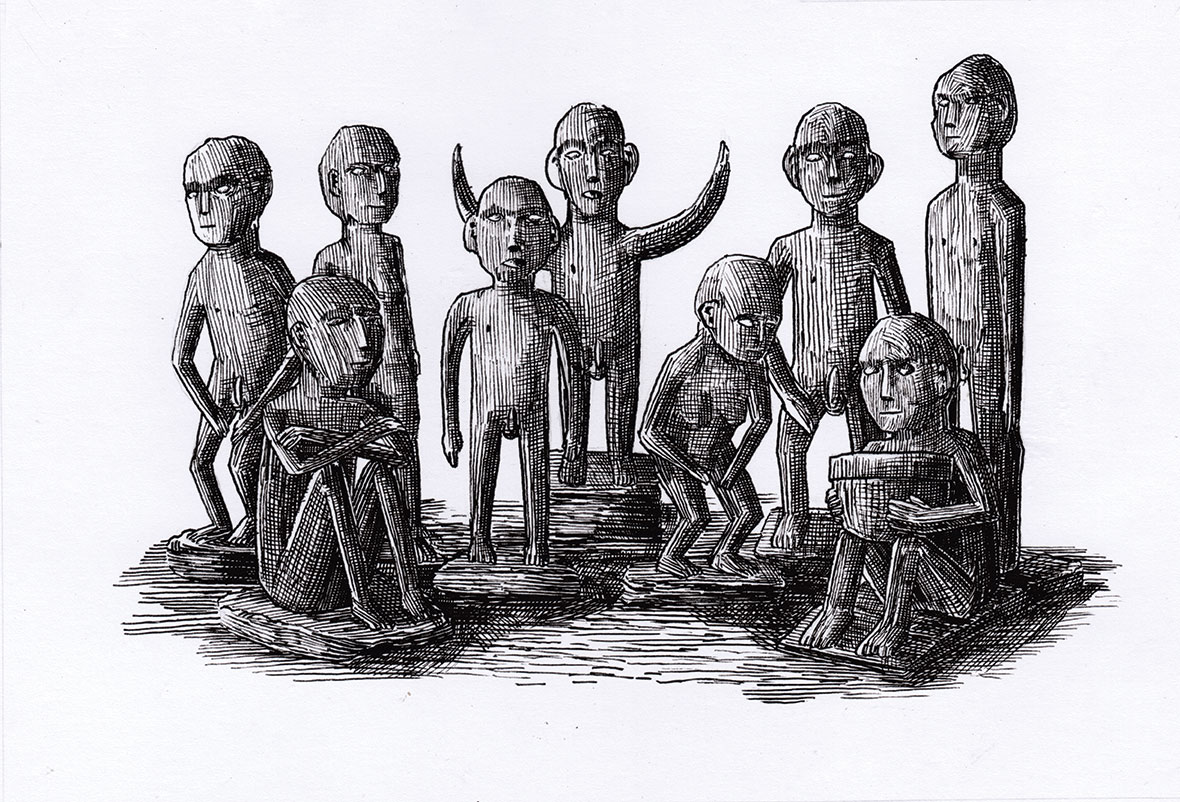
“The Dictionary of Philippine Mythology” is another recent piece of work celebrating the country’s folklore traditions. It’s an English-translated edition of a book dating back to 1895 cataloging the various mythologies across the country. It includes the original ethnographic maps and a compendium of Filipino tribes and languages, but now features an additional 59 historical photographs and 19 illustrations. ” I don’t think we should forget our roots,” says Ralph Reyes, who drew the illustrations. “Our culture is ever-evolving and Filipino folklore could always adapt to contemporary storytelling. We haven’t had enough representation, even locally.” He for one believes the stories, although he’s not sure he’s experienced any himself. “There are a lot of witnesses, especially in Mt. Makiling, where my family is from.”
Among Reyes’s new illustrations is the Aswang, one of FIlipino folklore’s most well-known creatures. In animal form, these monsters are often depicted as a very large pig or dog. They can also have long tongues, believed to be capable of sucking fetuses out of pregnant women. There’s also an Aswang of vampiric origins, those who delve more in witchcraft, and ghouls. But Reyes thinks the Hukloban is the most powerful mythical creature, as she can burn down a house with just the point of her finger. You can find her in the dictionary as well.
While the dictionary is more explicitly educational, there are a lot of artists taking creative license with the stories.
英译版《菲律宾神话词典》(The Dictionary of Philippine Mythology)是近期以当地民间传说为主题的另一部作品,其初版可追溯至 1895 年。当中记载了菲律宾全国各地大量神话故事,包括原始的民族志地图、菲律宾部落和语言的描述。现如今,又新增了 59 张历史图片和 19 幅插图。负责绘制插图的 Ralph Reyes 表示:“我们不应该忘记文化根源。我们的文化在不断发展,菲律宾民间传说也可以适应当代来进行叙述。一直以来,民间传说没能获得足够重视,即使在本地也是如此。”他甚至相信其中一些故事曾真实发生过,“尤其在我的家乡马基林山,很多人都曾亲身经历过,在民间口口相传。”
由 Ralph 新增的插图,包括 “毒裁梦魇” 阿斯旺(Aswang)——是菲律宾民间传说中最闻名遐迩的鬼怪之一,它们往往长着猪狗之类动物的躯干、长长的舌头,据说会从孕妇身上吸食胎儿。还有吸血鬼版本的阿斯旺,它们精通巫术。除此之外,Ralph 还认为胡鲁班(Hukloban)是字典中最强大的恶魔,手指随便一点就能烧毁一幢房子。后来很多艺术家,也是根据了这本字典,对传说进行艺术演绎。
Bastinuod, an illustrator from the central province of Cebu, is probably the most purposeful about the incorporation of folklore into his art. He’s well known for using art to speak out on charged topics, such as politics, disaster relief, and international issues like the war in Ukraine. His use of mythology is just as meaningful, and he recently created a month-long series depicting these creatures in modern times. “I try my best to incorporate Filipino elements in my artworks as my little way of contributing to the promotion and preservation of our culture,” he says. “Folktales are one of the oldest heirlooms we’ve inherited from our pre-colonial ancestors, and they’re a testament to how rich our culture is and was. I want to help define and preserve that heritage.”
Growing up, he was told to avoid doing certain things to avoid conjuring or disturbing spirits because of superstitions rooted in these folk tales. Although he doesn’t believe in them personally, he thinks studying them is valuable as a way to learn about Filipino culture.
In one recent piece from his folkloric series, Bastinuod depicts witches‘ embracing and laughing, with ants crawling along their touching hands and a bird in the upper right. “Langgam” in Bisaya means “bird” but in Tagalog means “ant” and the loose translation for “witch” is “Mangbabarang” and “Mangkukulam” in each language respectively. It’s a pan-Filipino image, using the words from different local languages that sound the same but mean separate things, to reimagine traditions in a more inclusive context. Another image from a few years back captures the custom of pouring the first drink of a bottle onto the ground. He was always told this was done because people believed that the top portion of the drink tastes different, but another interpretation is that it is an appeasement to Yawa, or rather a devil.
在当代一批围绕传说进行创作的艺术家中,来自中部宿务省的插画家 Bastinuod 是当之无愧的佼佼者。他擅长于在艺术作品中探讨极具争议的话题,譬如政治、灾难救助以及乌克兰战争等国际问题,使得他笔下的神话元素别具深意。最近,他用一个月的时间,将神话角色融入进现代场景中。“我会尽量在艺术创作中融入菲律宾的元素,也算是我为推广和保护本地文化付出的微薄之力,”他说道,“民间传说是我们从前殖民时代的祖先那里获得的最古老的传承之一,能充分展示了我们文化的丰富性。”
受到民间传说中的迷信思想的影响,小时候的 Bastinuod 常被大人告诫一些禁忌,一些行为可能会招引或打扰到鬼怪和神灵。即便他不是迷信之人,但他依然认为,研究这些民间传说有助于菲律宾文化的深入。
在最新的系列作品中,Bastinuod 描绘出女巫们谈笑风生的场景,蚂蚁沿着她们相互触碰的手爬行,乌鸦在手臂上驻足。“Langgam”一词在比萨亚语中意为小鸟,但在他加禄语中却代表蚂蚁,而“女巫”在这两种语言中大致可分别翻译为“Mangbabarang”和“Mangkukulam”。作者使用不同方言中发音相同、意思不同的单词,将这些词语的意象以一种更加包容的态度进行融合。几年前的另一幅作品中,他描绘了当地另一种习俗——饮料开瓶后的第一口要倒在地上,人们相信,饮料最上面部分的味道与饮料本身的味道不同,但还有另一种解释,认为是为了安抚魔鬼 “Yawa” 的情绪。
Patrick Gañas is another Filipino illustrator fond of drawing upon local folklore, and he revels in their dramatic and powerful nature. He grew up in and around Metro Manila and has been drawing mythology-inspired characters since childhood. “My elders and neighbors would tell me tales that haunted me in my sleep,” he laughs. He drew them in sketchbooks throughout his school ages and later even enrolled in a university class involving Philippine mythology. “The class rekindled the same enthusiasm I had for them as a kid.”
He says the inclusion of local folklore is actually a common theme for graduates with a fine arts degree searching for their artistic voice. “Although I grew up imagining ghosts around me, I knew, somewhere inside me, they would never show up in real life,” he notes. “But I’ve always respected our ancestors’ storytelling, the way they incorporate good values in a creative context. To spread that knowledge is a way to recognize that we belong to a beautiful tradition. If we abandon the memory of our past, we’ll lose the basis to move forward, halting our progress as a country in the process.”
In many of Gañas’s pieces, endless swirls of hair and smoke weave and dip into a wide tapestry that takes up most of the page. Manlalayog directly concerns a myth surrounding sentient, vengeful hair. In the original tale, a blind shaman with beautiful hair was abducted by colonizers who demonized powerful women and they proceeded to eat her. Her hair fell to the blood-soaked ground and absorbed her rage, turning into a monstrous incarnation of anger. Since the shaman wasn’t able to see her attackers, the creature directed its rage at any passerby. And then there’s Harionago, who uses her flowing white hair to camouflage herself in the snow, only appearing on the first day of snowfall. Its origin story is similar to that of the Manlalayog. “She was bound and mutilated by a group of men during the first day of snow while being forced to smile during her death,” Gañas explains. “Because of this, she inflicts the same horror on men who smile back at her.”
Patrick Gañas 尤其迷恋民间传说的戏剧性与惊心动魄的情节。他在马尼拉大都会及周边地区长大,从小喜欢画神话角色。“长辈和邻居经常跟我讲一些让我做恶梦的故事,”他笑着说。学生时期,他喜欢用素描本来画画,后来在大学时修读了关于菲律宾神话的课程。“这门课重新点燃了我儿时对神话故事的热情。”
他表示,对于美术专业毕业生来说,融入当地民间传说元素是一个共同的课题。他谈到:“故事的真实性虽有待考量,但对于祖先们口口相传的故事,我依然满怀敬意,这些天马行空的故事里蕴含着美好的价值观。推广民间传说也是对传统文化的肯定。如果我们抛弃过去的记忆,就失去了前进的基础,我们国家也会因此停下前进的步伐。”
在 Patrick 的许多作品中,毛骨悚然的发丝与烟雾交织在一起,几乎占据整幅画面。作品《Manlalayog》(曼德勒戈)的灵感来自一段关于头发复仇的传说。原著中,殖民者将拥有强大力量的女性视为妖魔,他们绑架了有着一头秀发的盲人萨满巫师,并打算吃掉她。萨满巫师的头发掉落在布满鲜血的地上,吸收了愤怒,成为可怕的化身。此外,他还曾以 “Harionago”(针女)创作过作品,针女以一头飘逸的白发在雪中伪装自己,只在落雪的第一天现身。针女的故事和 Manlalayog 有着相似之处,“在下雪的第一天,一群男人捆绑并肢解了她,强迫她在死去时仍然保持微笑,” Patrick 解释说,“正因如此,她对那些对朝她微笑的男人施加了同样的暴行。”
With such dark trails to follow in folklore, a lot of artists fully embrace the gory side of the stories. Doktor Karayom, whose trademark color is a bloody red, frequently incorporates mythologies into his dense murals, paintings, and sculptures. His work is rooted in supernatural mystery stories from movies, TV, and folk tales that he absorbed as a kid, and he often emphasizes the horror elements in his reinterpretations. “Aside from bringing back the memories and feelings from my childhood, I had learned to tell stories using my own world as inspiration.”
For one sculpture, he molded it into likeness of Filipino protective amulets called agimats. In another art piece, he draws his interpretation of a vampiric Aswang. Like many artists, he says that these tales are great for nurturing the imagination and allow for a lot of creative exploration. But he truly believes in them, and recounts several stories, including one that’s quite horrific: “Once when we were kids alone at my grandparents’, we heard our three dogs fighting in the yard at night. In the morning we found one poor dog with its body torn open and its internal organs missing. Its body was clean cut open. They said it was probably an Aswang or a Sigbin that attacked it. I still remember it clearly.”
对于这些带有暗黑色彩的民间传说,许多艺术家选择在创作中延续故事的恐怖一面。Doktor Karayom 的作品以血染的红色著称,涵盖了壁画、绘画和雕塑作品。创作灵感源于童年时看过的电影、电视剧和民间传说里的超自然神秘故事,以及他个人偏爱的恐怖元素。
他仿照菲律宾民间护身符(agimat,又称安亭)进行雕塑;还以自己的想象,重绘吸血鬼阿斯旺的造型。和许多艺术家一样,他认为这些民间传说夸大着自己的想象力,激发丰富的创意构想。他深信一些传说是真实存在,还分享了自己儿时一次非常可怕的经历:“有一次,我们几个小孩儿单独留在爷爷奶奶家,晚上我们听到三只狗在院子里打架。第二天早上,我们发现其中一只可怜的小狗身体被撕开,内脏都不见了。它的身体被干净利落地切开。人们都猜测元凶是阿斯旺或怪物 Sigbin(晚上出现,往往将鲜血从人或动物的影子中吸走),这件事我至今仍然历历在目。”
Other artists prefer to approach folklore with a more playful attitude, such as photographer Andrea Beldua, who recently shot a fashion editorial based on mythological characters. “At first, we just wanted to do something cute with fairy wings or elf ears,” she says. “But we thought it had already been done too much, so we wanted to go darker. More ‘ugly pretty.'” And so they landed on the idea of a high fashion interpretation of folklore. The editorial features a Mambabarang with butterfly adornments and long, steel nails; There’s also a Sirena mermaid with clear bubble nails and a chain link sheath dress. The Aswang stands out most though, reimagined as a high-fashion goth with ripped stockings, big black boots, and a lacey mask.
Although Beldua doesn’t believe in these stories, they’re fused with her childhood and were a big part of popular culture growing up. “A lot of my friends really believed, and would say ‘tabi tabi, po‘ whenever they’d pass by a grassy area or a big tree,” she recalls, which is a way of saying “excuse me” to spirits when passing the kind of areas they’re believed to inhabit.
Beldua and her team aren’t the only ones to explore folklore and fashion in recent times. Designer Axel Que created a dress in the form of a Bakunawa serpent-like dragon. The dress was worn by Beatrice Luigi Gomez as she competed for the Philippines in the Miss Universe 2021 pageant.
另有一批艺术家,则希望以相对轻松的角度借用民间传说,例如摄影师 Andrea Beldua。最近,她拍摄了一组以神话人物为原型的时尚大片。“最初,我们是想用仙女翅膀或精灵耳朵,拍一些偏可爱的造型,”她介绍着说,“但又觉得类似的照片已经拍过很多,所以想尝试点别的,吊吊胃口”。最终,他们将视角放在了民间传说。其中一位模特儿打扮成女巫 “Mambabarang” 的模样,佩戴蝴蝶装饰和钢钉;另一位主角化身海妖 “Sirena”,身着铁链编制的紧身裙,亦有水滴状美甲加持;其中最引人注目的还是阿斯旺造型——破洞丝袜、夸张的黑色靴子和蕾丝口罩,以高定时装的哥特风格重新演绎。
Andrea 不迷信,但这些民间传说已经成为她的童年的一部分,也是她从小所接触的流行文化中的重要组成部分。她回忆道:“我有很多朋友真的相信这些传说,他们每次经过草地或大树时,都会说‘tabi tabi,po’。”这是人们在经过神灵所在的地时,担心冒犯而表达 “不好意思” 的方式。
在时尚领域,借鉴民间传说元素的并非只有 Andrea 和她的团队。设计师 Axel Que 以菲律宾神话中的巨龙巴库那瓦(Bakunawa)为原型,设计了一条连衣裙。在2021年环球小姐选美比赛上,Beatrice Luigi Gomez 曾穿着这条裙子代表菲律宾参赛。
“Trese” may have helped Filipino folklore reach new, contemporary heights, but it started as a humble ashcan komik, photocopied by its creators and sold hand to hand locally, taking many years to garner the level of attention it has now. It’s not alone either. Ella Arcangel is another komik-turned-cartoon with plenty of nods to local folk tales. The story follows a band of kids in a squatters’ village battling evil creatures. Although the character art is drawn in a cartoony style, its subject matter leans decisively into the adult horror genre. And there are at least a dozen podcasts cataloging Pinoys’ encounters with the mythic realm. Book series like True Philippine Ghost Stories have also dutifully done the same.
如今,动画《灵探特莱丝》让菲律宾民间传说获得了前所未有的关注。而它的雏形,最初只是一本很不起眼的迷你漫画书,之后随着多年的积累和努力,才有了现在的成就。另一部动画《Ella Arcangel》同样改编自菲律宾民间传说,讲述了一群孩子在村庄里与邪恶斗争的故事。即便片中的角色都是卡通风格,但故事和内容却是不折不扣的成人恐怖类型。除此之外,还有至少十几个电台播客,持续讲述菲律宾神秘世界的故事;当地还曾发行过《真实菲律宾鬼故事》(True Philippine Ghost Stories)系列丛书等等。

Folklore might not be as central to Filipino life as it was centuries ago, but it’s still quite common. All these pop culture influences; old tales from lola (grandma) or shared stories from pinsan (cousin); veteran artists like sculptor Roberto Feleo or the 60-artist strong exhibit “Filipino Myths and Legends” from 2014 help cement folklore in Filipino lives. There’s even an Aswang NFT of various creatures already. Mythology is embedded in the culture and piles up in the subconscious. Oftentimes, it’s just a natural influence, with artists instinctively pulling these subjects from their everyday lives. It’s extremely Filipino, which also gives it value beyond some trend or novelty. As many of the artists have said above, the tales are a way to communicate their history and identity amongst themselves and to the rest of the world. It’s a means of finding pride in a culture so frequently trampled by colonialism. And the lessons embedded within the tales themselves, whether one believes them true or not, hold important values. This generation of artists is only the most recent to draw inspiration from folklore, and hopefully the next will continue the tradition.
虽然民间传说已经不像几个世纪前那样占据菲律宾人生活的中心,但其影响仍可见一斑。无论是亲朋邻里在茶余饭后的分享、还是 Roberto Feleo 等资深艺术家的创作、抑或是 2014 年 60 位艺术家共同举办的展览“菲律宾神话和传说”(Filipino Myths and Legends)、以及由各种神话角色组成的 Aswang NFT 项目等等,这些人、这些事,都巩固着民间传说在菲律宾人生活中的比重。
神话故事根植于文化之中,潜移默化地影响着我们的行为和思想,一切自然发生。艺术家们本能地从日常生活中借鉴这些元素。正因为是菲律宾本土特色的属性,也因此超越了流行和猎奇意味的价值。正如许多上述艺术家所说,这些故事是传达菲律宾历史和身份的一种方式,让他们从殖民主义的践踏中找到共鸣、并引以为傲的途径。无论人是否迷信,这些故事本身所蕴含的意义和智慧都具有不凡价值。这一代艺术家是最新一批从民间传说中汲取创作灵感的艺术家,他们对于传统的执着与敬畏心,但愿可以代代相传。
Like our stories? Follow us on Facebook and Instagram.
Instagram:
@__r.angelo
@bastinuod
@patrick.ganas
@andreabeldua
Contributor: Mike Steyels
Chinese Translation: Olivia Li

